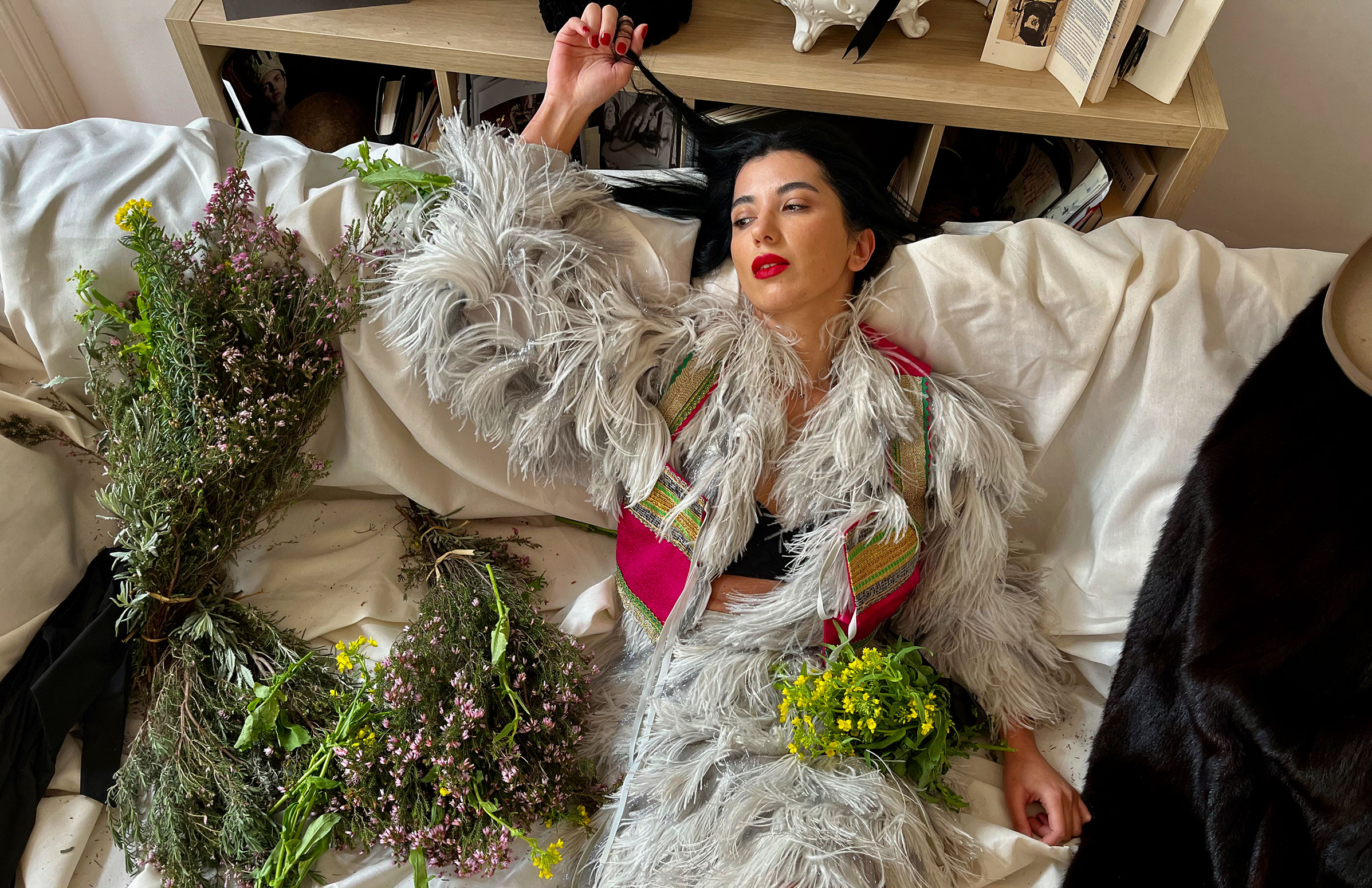
Iranian textile heritage: an exceptional range of fabrics
Iranian textile heritage spans millennia and encompasses an exceptional range of fabrics and techniques: from ancient plant fibres like hemp, linen, and regional cottons to prized animal fibres such as silk, camel hair, and cashmere. Artisanal processes include hand-block printing (Ghalamkar), sumptuous brocades (Termeh), flat-weave constructions (Jajim, Kilim, Soumak), and richly embellished embroideries (Pateh, Sermeh, Balochi needlework), as well as traditional felting (Namad). Decorative motifs—Gol Farangi’s naturalistic florals, Shah Abbasi’s palmettes, and the boteh (paisley)—infuse the textiles with symbolic meaning. Major weaving centres such as Yazd, Isfahan, Kerman, Kashan, Tabriz, and Nain have each contributed unique interpretations of these techniques, while UNESCO recognition and sustainable‐fiber initiatives are fueling a contemporary revival.
Natural Plant Fibers: Hemp, Linen, and Regional Cottons
Hemp
Hemp was among the earliest fibres cultivated in the Iranian plateau, with archaeological finds of hemp cloth dating back over 10,000 years in Mesopotamia (modern-day Iran and Iraq). Today, hemp is being reconsidered for its sustainability credentials—strong, rot-resistant fibres that require minimal agrochemicals—echoing its ancient prominence.
Line
Linen, produced from flax, has a quieter but enduring presence in Iranian textile history, serving as a lightweight, breathable cloth for hot summers. In regions like Isfahan and Shiraz, linen also forms a base for Ghalamkar printing, where block-stamped patterns enhance its natural-forged texture.
Regional Cottons
Regional Cottons, especially those from Khuzestan and Fars provinces, were historically spun and woven into coarse cloth for rural use, while finer cottons travelled along the Silk Road. The adaptability of cotton underpins the popularity of Ghalamkar bedspreads and garments across Iran.
Animal Fibres: Silk, Camel Hair, and Cashmere
Silk cultivation
Silk cultivation (sericulture) thrived in Khorasan and Qazvin, with Iran listed by UNESCO for Sericulture and traditional production of silk for weaving in 2022. Qom emerged as a preeminent rug-weaving centre in the early 20th century, famed for high‐knot-count silk and wool carpets, reflecting a shift from agrarian sericulture to luxury textiles.
Camel Hair
Camel Hair is prized for its softness, insulating properties, and lustrous drape. Harvested from Bactrian camels in Iran’s eastern deserts, camel hair fabrics are woven into coats and blankets that combine warmth with elegance.
Cashmere
Cashmere, derived from wild goats in the Alborz mountains, contributed delicate fine-twist wools to Qajar-era brocades alongside silk in Termeh production. Modern Iranian Termeh sometimes blends cashmere for added softness and drape.
Hand-Block Printing: The Art of Ghalamkar
Ghalamkar
Ghalamkar (Persian: قلمکاری) is the meticulous practice of wood-block printing on cotton, linen, or silk using hand-carved pear-wood blocks and mineral dyes. Originating in Safavid Shiraz and Isfahan, artisans register successive blocks to render arabesque vines, florals, and narrative scenes in precise, repeating patterns. The breathable durability of Ghalamkar cloth has made it a staple for table linens, bed covers, and lightweight apparel for centuries.
Flat-Woven Textiles: Jajim, Kilim, and Soumak
Jajim
Jajim is a reversible, flat-woven textile woven from wool or wool-cotton blends, composed of narrow panels sewn together, creating bold vertical stripes. Traditionally used by nomadic tribes for blankets, tent covers, and cargo cloths, Jajim’s versatility extends to modern home décor and fashion accessories.
Kilim
Kilim tapestry weaving produces pile-less rugs and wall hangings with crisp geometric motifs. Found across Iran’s tribal regions—Shiraz gilims, Kurdish mats, and Qashqai horse covers—kilims function as floor coverings, bedding, and caravan trade goods.
Soumak
Soumak is a brocading technique in which extra-weft threads are wrapped around warps to build a tapestry-like surface that is stronger and thicker than kilim. Prevalent among Lur and Shahsevan weavers, and along the Iran-Turkey frontier, Soumak produces durable bags, mats, and decorative bands featuring herringbone or zigzag patterns.
Embroidered Textiles: Pateh, Sermeh, and Balochi Needlework
Pateh of Kerman
Pateh of Kerman is a wool-base embroidery worked in silk threads, depicting cypresses, boteh, and floral sprays over months of painstaking needlework. The dense stitching creates richly textured shawls, wall hangings, and ceremonial cloths.
Termeh Embroidery
Termeh Embroidery employs metal threads (originally gold and silver, now alloys) to outline arabesques on velvet or silk, reaching its zenith under the Safavids in Isfahan and Yazd, with contemporary artisans preserving traditional stitches.
Balochi Needlework
Balochi Needlework is practiced by the Baluch people of Sistan-Baluchestan, combining geometric and floral motifs in symmetrical layouts on garments and accessories. Recognized for its cultural significance, it exemplifies Southeastern Iran’s needle-craft precision.
Felted Fabrics: Namad and Kolah Namadi
Namad (felt) predates weaving in Iran, crafted by matting and pressing wool fibres into robust sheets. Nomadic tribes in Kermanshah and the Zagros produce floor mats, tent liners, and the iconic Kolah Namadi hats, valued for insulation and ease of manufacture.
Decoration and Pattern: Gol Farangi and Shah Abbasi
Gol Farangi
Gol Farangi (European flower) is a pictorial motif inspired by wildflowers and rose gardens, woven in carpets and brocades to evoke lifelike blooms. Variants such as Gol Farangi Bijar and Dastegol harness naturalistic color contrasts for vibrant effect.
Shah Abbasi Motif
Shah Abbasi Motif, named for Safavid king Shah Abbas I, features palmette clusters, rosettes, and arabesque scrolls arranged symmetrically around a central medallion. Its enduring grace appears across carpets, Termeh brocades, and block-printed textiles.
Regional Rug Weaving as Textile Tradition: Tabriz, Nain, and Kashan
Tabriz
Tabriz emerged in the 16th century as a Silk Road weaving hub, its rugs celebrated for pictorial scenes, high knot densities, and lavish materials like silk and camelhair.
Nain
Nain rugs, distinguished by ivory-field medallions and silk accents, reflect technical finesse with knot counts exceeding 800 per square inch. Their designs fuse Isfahan’s floral lexicon with Khorasan’s color palettes.
Mohtasham-Kashani
Mohtasham-Kashani pictorial carpets of late 19th-century Kashan depict figural scenes—hunting parties, landscapes—in silk and metal threads, showcasing the weaver-poet Mohtasham’s masterful narrative compositions.
Contemporary Revival and Sustainability
UNESCO inscriptions—Traditional skills of carpet weaving in Fars and Kashan (2010) and Turkmen-style needlework art (2022)—have galvanized preservation initiatives. Iran’s Cultural Heritage Ministry also funds workshops for Jajim and Termeh weavers, while eco-textile startups are exploring organic hemp and linen blends to reduce cotton’s water footprint.
Conclusion
The multifaceted textiles of Iran embody centuries of innovation, from prehistoric hemp cloth to imperial brocades and tribal flat-weaves. Each fibre and technique carries regional identity and symbolic depth—whether through a Kerman Pateh’s floral allegory or a Shah Abbasi carpet’s royal pageantry. Today, a resurgence in craft education, UNESCO recognition, and sustainable fibre use is ensuring that these storied traditions continue to flourish and inspire global design.


